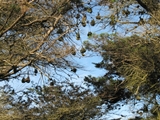Thick-billed Weaver range expansion 2011-04-04 (104)
The Thick-billed Weaver arrived in Gauteng in the early 1960s from Mpumalanga, and slowly increased in numbers. Johannesburg and Pretoria have many parks and wetlands with reed beds which provide ideal nesting sites for this species. In the non-breeding season it feeds on seeds, fruits and insects. In the original range, these were mainly obtained in forests, but the gardens of Gauteng provide a suitable alternative habitat with adequate food. The SABAP2 range-change map shows that in recent years the population has increased dramatically in Johannesburg and Pretoria and that this species is expanding its range beyond Gauteng. The range change observed for this species seems to be mostly accounted for by changes to the habitat (rather than to climate change). There are several PHOWN records for this species, including records in Gauteng.
 This is part of the range change map between SABAP1 and SABAP2 for the Thick-billed Weaver. This map is centred on Gauteng, and includes some of the northern Free State, eastern North-West Province, southern Limpopo and western Mpumalanga! The top number in a quarter degree grid cell (QDGC) is the reporting rate in SABAP1, the bottom number is the SABAP2 reporting rate. Thick-billed Weavers were recorded in the GREEN, ORANGE and RED QDGCs in SABAP1. The BLUE QDGCs represent new range in SABAP2. In this region, there are seven RED QGDCs where Thick-billed Weavers were recorded in SABAP1 but not yet in SABAP2. There are three ORANGE QDGCs where the reporting rate is now slightly lower than in SABAP1. In contrast to these figures, there are 20 GREEN QDGCs where the reporting rate has increased, and in many of these the increase has been substantial. This is especially true of the eight GREEN QDGCs in Gauteng. In one of them the reporting rate is approaching 50%! In much of the new range, in BLUE, the reporting rates exceed 10%.
This is part of the range change map between SABAP1 and SABAP2 for the Thick-billed Weaver. This map is centred on Gauteng, and includes some of the northern Free State, eastern North-West Province, southern Limpopo and western Mpumalanga! The top number in a quarter degree grid cell (QDGC) is the reporting rate in SABAP1, the bottom number is the SABAP2 reporting rate. Thick-billed Weavers were recorded in the GREEN, ORANGE and RED QDGCs in SABAP1. The BLUE QDGCs represent new range in SABAP2. In this region, there are seven RED QGDCs where Thick-billed Weavers were recorded in SABAP1 but not yet in SABAP2. There are three ORANGE QDGCs where the reporting rate is now slightly lower than in SABAP1. In contrast to these figures, there are 20 GREEN QDGCs where the reporting rate has increased, and in many of these the increase has been substantial. This is especially true of the eight GREEN QDGCs in Gauteng. In one of them the reporting rate is approaching 50%! In much of the new range, in BLUE, the reporting rates exceed 10%.
Source: Les Underhill
|











 This is part of the range change map between SABAP1 and
This is part of the range change map between SABAP1 and